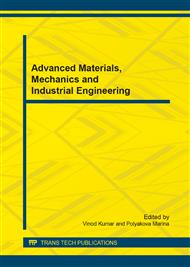[1]
D .K. Subramanya , A.E. Swansiger, H.S. Avery, Austenitic Manganese Steels, 10th Edition, ASM Metals Handbook, Vol. 1, 1991, pp.822-840.
Google Scholar
[2]
D.K. Subramanyam, G.W. Grube, H.J. Chapin, Austenitic Manganese Steel Castings, 9th Edition, ASM Metals Handbook, Vol. 9, 1985, pp.251-256.
Google Scholar
[3]
S. Chakrabartti, Cast Austenitic Manganese Steels Some Practical Notes , www. cbgfoundry. com.
Google Scholar
[4]
I. Karaman, Ph.D. Thesis, University of Illinois, Chicago, (2000).
Google Scholar
[5]
E.A. Aleshina , O.V. Sizova , Formation of Structural-Phase States of the Surface of Hadfield Steel, Steel in Translation, 2007, Vol. 12, pp.989-990.
DOI: 10.3103/s0967091207120042
Google Scholar
[6]
E.G. Zakharova, I.V. Kireeva, Yu.I. Chumlyakov, Strain Hardening and Fracture of Austenitic Steel Single Crystals with High Concentration of Interstitial Atoms, Russian Physics J, 2002, Vol. 45, pp.274-284.
Google Scholar
[7]
T. Sasaki, Physical and Mechanical Properties of High Manganese Non-Magnetic Steel and its Application toVarious Products for Cammerical Use, Transactions ISU, 1982, Vol. 22, pp.184-192.
Google Scholar
[8]
A.K. Srivastava, K. Das, Microstructural Characterization of Hadfield Austenitic Manganese Steel, Materials Sciences, 2008, Vol. 43, pp.5654-5658.
DOI: 10.1007/s10853-008-2759-y
Google Scholar
[9]
P.H. Adler, G.B. Olson, and W.S. Owen, Strain Hardening of Hadfield Manganese Steel, Metall Trans, 1986, Vol. 17A, pp.1725-1737.
DOI: 10.1007/bf02817271
Google Scholar
[10]
M. Ravandoost, M. Naghavi, M.H. Shaeri, Effect of Direct Quenching on Hadfield Steel Micro Structure, 11 th annual conference of Iranian Metallurgical Engineers Society, 1368.
Google Scholar
[11]
G.F. Liang, and C.J. Song, Eutectic Decomposition in Ca-Si Modified Austenitic Medium Mn Steel after Solidification, Materials Sciences, 2005, Vol. 40, p.2081-(2084).
DOI: 10.1007/s10853-005-1240-4
Google Scholar
[12]
P.W. Mason and P.S. Prevey, Iterative Taguchi Analysis: optimizing the austenite content and hardness in 52100 steel, Journal of Materials Engineering and performance, Vol. 10(1), February 2001, 14-21.
DOI: 10.1361/105994901770345286
Google Scholar
[13]
M. Joseph Davidson, K. Balasubramanian, G.R.N. Tagore, Experimental investigation on flow-forming of AA6061 alloy-A Taguchi approach, journal of materials processing technology , 2008(200): 283–287.
DOI: 10.1016/j.jmatprotec.2007.09.026
Google Scholar
[14]
Adem Cicek, Turgay Kivak, Gurcan Samtas, Application of Taguchi Method for Surface Roughness and Roundness Error in Drilling of AISI 316 Stainless Steel, Journal of Mechanical Engineering, 58(2012)3, 165-174.
DOI: 10.5545/sv-jme.2011.167
Google Scholar


